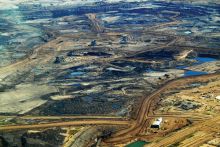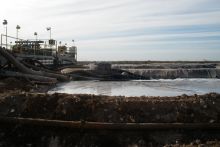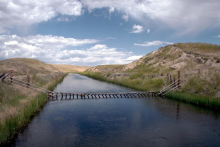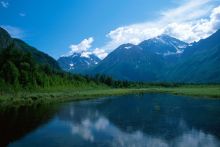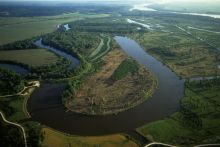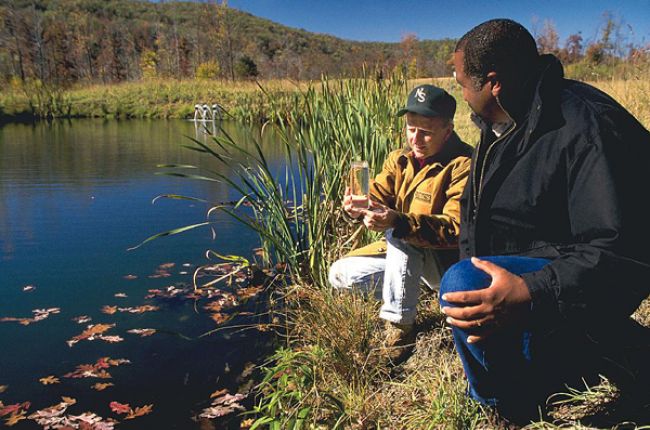
Material adapted from: Vandas, S.J., Winter, T.C., and Battaglin, W.A. 2002. Water and the Environment, p. 42-44. Published by the American Geosciences Institute Environmental Awareness Series. Click here to download the full handbook.
Many factors affect the quality of surface and groundwater. Water moving over or under the land surface can undergo physical and chemical changes. These changes may be caused by either natural factors or human activities.
Contaminants can impair water quality and affect water use. A contaminant is an undesirable substance in water that either is not normally present or is a naturally occurring substance at an unusually high concentration. Contaminants can be divided into four general classes:
These contaminants can contribute to water by either point or non-point sources. Point sources contribute contaminants at a discrete site, such as the outflow from a pipe, ditch, tunnel, well, concentrated animal-feeding operation, or floating craft. These sources can be controlled to some degree by treatment at or before the point of discharge.
Non-point sources contribute contaminants from a broad area; as a result, such sources are not as easily identified or controlled as point sources. Non-point sources include the atmosphere, agricultural areas, golf courses, residential developments, roads, parking lots, and contributions from groundwater along lengthy reaches of streams.
Sediment and Natural Organic Materials
Sediment is defined as particles derived from soil, rock, or organic matter that have been, or are being, transported by water or wind. Natural organic materials include plant debris, and human and animal wastes. The erosion of land surfaces and stream banks produces sediment. Erosion occurs naturally, but human activities, like farming, logging, or road construction can increase sediment transport to and within streams. Wildfires can also increase the erosion of sediment by removing vegetation that stabilizes soils and slopes. Sediment deposited in streams can restrict navigation. Sediment can also increase the potential for floods by decreasing reservoir storage and stream-channel capacity. Suspended sediments contribute to the reduction of water clarity and quality. Fine sediments can severely alter aquatic communities by clogging fish gills and suffocating fish eggs and aquatic insect larvae. Harmful materials such as heavy metals and toxic chemicals can attach to sediments and move with them down the stream system. Sediment is a major water quality issue in most places.
Nutrients
Nutrients are any organic or inorganic compound needed to sustain life. Examples include carbon, nitrogen, phosphorus, and potassium. Nutrients are contributed to waters from the atmosphere, agricultural lands, golf courses, lawns, septic systems, wastewater treatment plants, and factories. Wildfires can also increase nutrients in water from burned vegetation. An excess amount of nutrients in water can result in a disproportionate amount of aquatic vegetation. The decomposition of this excess vegetation can remove oxygen from water and cause fish and other aquatic life to die. An overabundance of aquatic vegetation can also interfere with recreation. High nitrate or ammonia concentrations can impact drinking water or kill fish. Nitrate and ammonia are forms of nitrogen.
Bacteria
Some bacteria are disease-causing organisms that may be delivered to surface water and groundwater by sewer overflows, leaking septic tanks, and runoff from animal feedlots or pastures. Some bacteria are a threat to humans, and indicator organisms such as fecal coliform are used to determine their presence. Indicator bacteria are found in great numbers in the intestines of humans and other warmblooded animals. When water tests confirm the presence of the indicator bacteria, the water body may be contaminated by untreated sewage and other more dangerous organisms may be present.
Toxic Substances
In sufficient quantities, toxic substances, such as cleaning solvents, pesticides, and certain metals, can cause sickness, genetic disorders, and even kill organisms. Toxic chemicals can enter waters through direct discharge from industry or by improper disposal of industrial, mining, farm, and household wastes. Wildfires can introduce contaminants into the air and water, for example when urban debris is burned or contaminated soil is moved by water post-fire. Contaminants contributed from industrial uses of water include toxic substances produced from cleaning solvents, acids, and alkalis. The over application of pesticides can result in the excess entering waters through runoff to surface water and infiltration into groundwaters.
Even extremely low concentrations of some chemicals are hazardous to humans and aquatic life. Toxic substances also can affect an organism’s growth, metabolism, reproduction, or behavior. The potential dangers of many toxic substances are only now being recognized. Assessing the environmental dangers of these substances has been enhanced as our ability to detect smaller concentrations has improved and our understanding of their effects on the environment has increased.
Learn More
- National Water-Quality Assessment (NAWQA) Program (Website), U.S. Geological Survey
Links to national water quality studies and publications, including regional and national assessments on water-quality status and trends for surface water and groundwater, as well as national synthesis assessments on pesticides, volatile organic compounds, nutrients, trace elements, and aquatic ecology.
- Water Quality Standards: Regulations and Resources (Website), Environmental Protection Agency
Information hub for water quality information, including federal and state regulations and standards, resources for tribes, and more.
- Water Quality Standards Handbook (Website), Environmental Protection Agency
EPA's guidance for water quality standards, with recommendations for "reviewing, revising, and implementing" water quality standards.
- Surf Your Watershed (Interactive Map), Environmental Protection Agency
Searchable data hub allowing users to find information on water quality and other environmental information for watersheds across the United States.
- Desalination as a Source of Fresh Water (Webinar), American Geosciences Institute
Webinar discussing various treatment options for desalination of salty water to make it potable, as well as the removal of contaminants from water sources.


